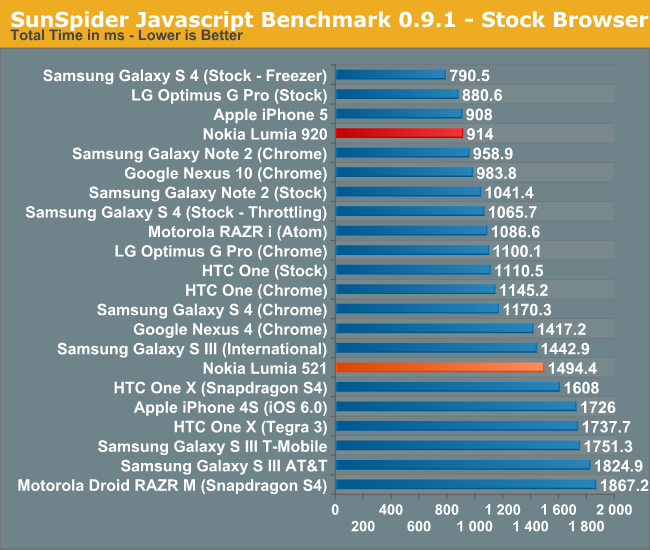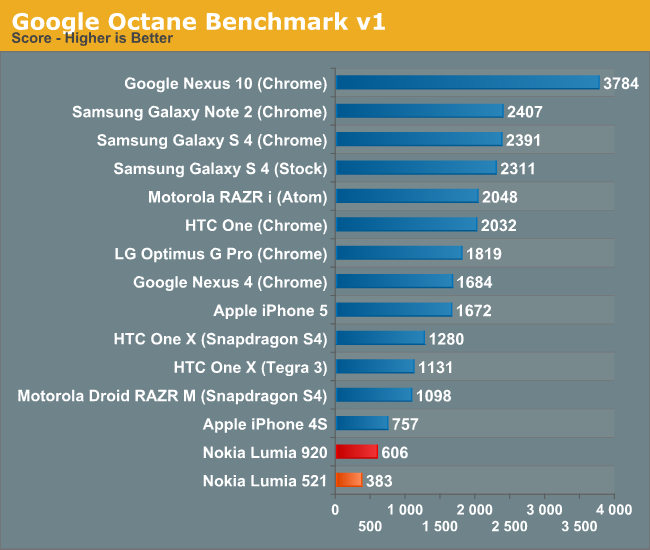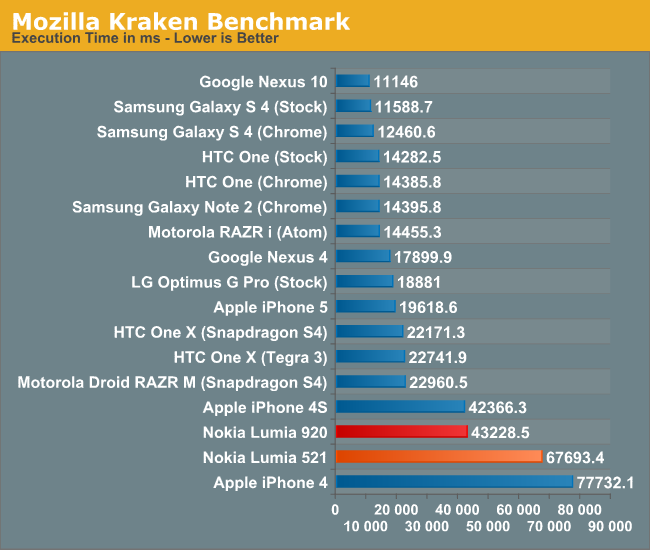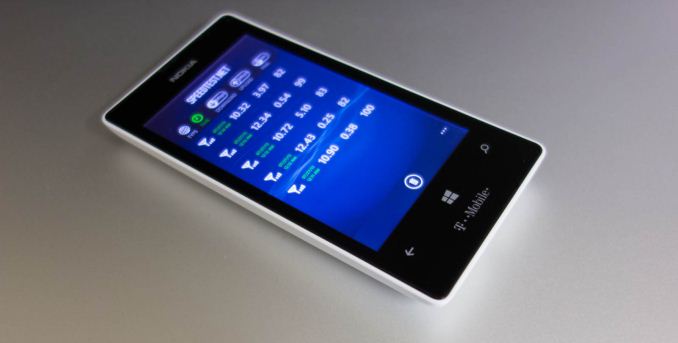Nokia Lumia 521: Quality Smartphone on an Extreme Budget
by Vivek Gowri on August 8, 2013 1:08 AM EST- Posted in
- Smartphones
- Nokia
- Mobile
- windows phone 8
- Lumia 520
- Lumia 521
Our smartphone benchmarks are centered around browser-based tests, and this is one area that really shows how far behind Internet Explorer 10 Mobile is relative to the mobile versions of Safari and Chrome. The other part of this is looking at Krait 200 at 1GHz versus the higher-clocked parts we see in the more expensive Windows Phones, which allows us to look at relative performance on the same software platform.


 Sunspider performance is actually quite good, especially compared to other Krait 200-based devices like the One X and AT&T Galaxy S3. Where it falls off is in everything else—Kraken and Octane performance is just horrendous in comparison to the modern smartphone platforms. I didn’t think it was actually possible to see numbers that high in the Kraken benchmark until I ran it a half-dozen times on my 521 review unit as well as a friend’s Lumia 920. Microsoft clearly optimized for Sunspider, as we’ve seen over the years, and while that lets them stay competitive in that one benchmark, it doesn’t really mean anything as far as having decent or even acceptable browser performance. It’s just sad.
Sunspider performance is actually quite good, especially compared to other Krait 200-based devices like the One X and AT&T Galaxy S3. Where it falls off is in everything else—Kraken and Octane performance is just horrendous in comparison to the modern smartphone platforms. I didn’t think it was actually possible to see numbers that high in the Kraken benchmark until I ran it a half-dozen times on my 521 review unit as well as a friend’s Lumia 920. Microsoft clearly optimized for Sunspider, as we’ve seen over the years, and while that lets them stay competitive in that one benchmark, it doesn’t really mean anything as far as having decent or even acceptable browser performance. It’s just sad.
Between the 920 (MSM8960, so dual-core Krait 200 @ 1.5GHz and Adreno 225) and the 521, there’s a definite performance delta. Obviously, this comes through in roughly 50% faster benchmark numbers across the board, but in day to day use, it mostly makes itself felt in slower application loading and multitasking/task switching, which is also related to having just 512MB RAM instead of the 1GB of the 920. Multitasking in Windows Phone has never really sat well with me, because it’s not really multitasking in the traditional sense—the need to completely close and rehydrate tasks makes resuming applications exceedingly slow. Microsoft has always seemed to have an issue with app load times with ARM devices—this has been true since day one with Windows Phone, and is a problem with Windows RT tablets too—so the resulting combination can really kill any desire to run more than one task on your phone at a time.
I couldn’t run GFXBench (DXBenchmark) on the 521 because it didn’t meet the 1GB RAM requirement necessary to run the benchmark. I actually wasn’t even aware that GFXBench had such a requirement in place until I tried to install it on the 521. In the grand scheme of things, I suppose it doesn’t matter too much—we’re pretty familiar with Adreno 305 by now, and it seems to be the go-to GPU for Qualcomm’s new series of dual-core Krait 200 SoCs. In a platform that deemphasizes silicon performance in the end user experience as much as Windows Phone seems to, I’m not sure that the performance delta between this and Adreno 225 makes too much of a difference, particularly with a far lower-res screen. We’re starting to see the more 3D intensive games require 1GB of memory to run, so this isn’t the device for the hardcore gamers. It does fine with the typical slate of casual games though—Fruit Ninja, Angry Birds, and the like.
The air interface is probably something you could point to and say is a bit lacking—in this day and age, dual carrier HSPA+ is almost an expectation on T-Mobile and international non-LTE devices. But honestly, you don’t end up missing it much. T-Mobile’s HSPA+ network is quite robust both in Seattle as well as in Silicon Valley, the two places I spent time testing the 521, so 10+ Mb/s was basically the norm.
I couldn’t figure out how to get the Windows Phone SpeedTest app to email a CSV of the test results, so no graphs with binned speed tests like we have on Android reviews. We’ve had a lot of experience with T-Mobile’s HSPA+ network over the years though, and it tends to be very good in most metropolitan areas. Obviously, there’s a significant jump in speed between HSPA+ and LTE, but the real-world difference between single and dual-carrier HSPA+, at least on T-Mobile, seems to be much harder to discern perceptively. The lack of DC-HSPA+ is still a bit of a disappointment, but I’m not nearly as cut up over it as I was when I saw it on the specsheet.











116 Comments
View All Comments
Gunbuster - Thursday, August 8, 2013 - link
This may be down to confusion on how to "re-open" an app. If you long press the back arrow capacitive button you get the running apps and have almost no lag. If you hit windows and select the live tile for an already open app it kills that app and loads it again fresh. I don't really agree with that design choice as it seems to confuse most users.Myrandex - Thursday, August 8, 2013 - link
You can hit the start button, go back to the homescreen, and select an app and still get fast refresh. It still needs to be recently run though. I do this frequently.Collin5 - Thursday, August 8, 2013 - link
It seems unlikely that Vivek doesn't know about the task switcher, but who knows?However, not all apps are reloaded when relaunched from a live tile. Some apps support a feature called "fast resume", which allows them to resume instantly, even when reactivated via a live tile. Unfortunately, apps must support this feature explicitly, and the fact that not all do leads to behavioural inconsistencies, which is why I agree with you (and Vivek) that at least this aspect of WP multitasking is poorly designed. Fast resume support must be mandatory.
althaz - Thursday, August 8, 2013 - link
This is the same behaviour as iPhone and Android (disclaimer: I haven't used an iPhone for over a year).Azurael - Friday, August 9, 2013 - link
I was about to say I very rarely encounter this issue on my phone, but then I remembered that the Nexus 4 has 2GB of RAM so it's not exactly an Apples to Apples comparison. I usually have to run 10+ apps to start seeing the reload on taskswitch behaviour...Android, however, doesn't relaunch apps if you select them from the home screen - the behaviour is exactly the same (and instant, if the app has already been launched) as using the task switcher.
I guess the biggest difference in reality is that - at least in theory - Android 4.x devices should have a task switcher button, which is a lot more obvious to the user than holding back. Having said that, a lot of 'three button' Android devices are stuck with an obsolete and practically useless menu button instead due to pigheaded device manufacturers ignoring Google's UI guidelines, and then we're stuck with the same behaviour but holding the home button instead...
Seurahepo - Friday, August 9, 2013 - link
No, it is NOT. iPhone apps are not "reactivated" when launched from the home screen. No matter how the user comes back to an app it is instant (provided it has been recently used and it is still in memory).Could some of you WP fans explain to me *why* the apps are slowly restarted from the live titles? Blaming the users are using the phone wrong is kind of defensive, seems like there is a big UI/UX problem for no apparent reason.
althaz - Thursday, August 8, 2013 - link
This is entirely dependent on the app devs actually. Most do choose to reload the app if you go back to the start screen and then load the app.Impulses - Friday, August 9, 2013 - link
That's madness... Because people who are new to smartphones tend to ignore quicker methods of multi-tasking and usually resort to tapping home and reopening apps from shortcuts/tiles/all apps...At least that's what I've observed among older clients and family members of mine, regardless of OS. If they're on an iPhone they'll seldom double tap home (if they even know about it) and on Android they flat out ignore the app switching button (a decision reinforced by HTC's choice to eliminate it I imagine, or hide it behind multiple home taps rather).
toraji - Friday, August 9, 2013 - link
good points collinmi1stormilst - Thursday, August 8, 2013 - link
I just picked up one on Craigs List for $115 new in the box (from HSN deal). It came with a cheap pair of headphones, car charger and a soft case. I charged it up and went to the t-mobile website to sign up for the $30.00 a month pre-paid plan (100 mins of talk time, unlimited text and data). I am using it as a home phone and a phone for my two youngest kids to share when they are away from home. We all like the physical phone, camera is decent (needs a flash) and the interface is clean and fun. The speed of the OS is mostly snappy the data connection is faster than expected. Battery life is more than acceptable if you are not playing and staring at it all day. I only have two complaints: 1.) The OS does seem to slow down occasionally in different screens especially when trying to type in the keyboard. 2.) It is not clear how to close down apps or navigate in the Browser. I am satisfied with the phone overall and have recommended it to budget minded folks.